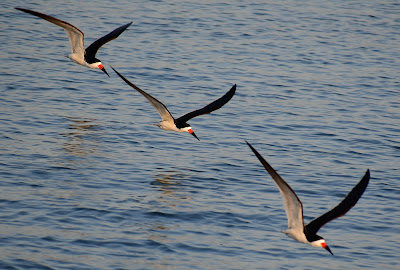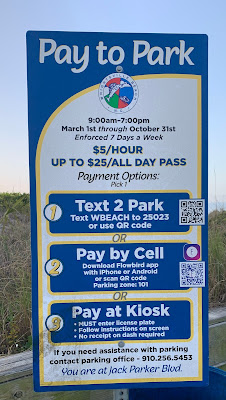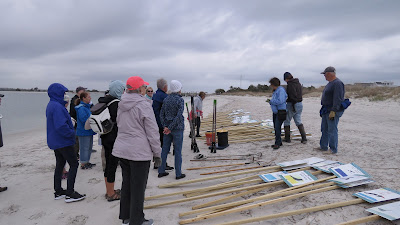As the sun was rising early this morning (4/14/2022) the birds could be seen and heard as we walked onto the beach.
We were greeted by Black Skimmers, Least Terns, Common Terns, two pairs of American Oystercatchers and Willets. It is a great time to head to the beach and watch as our birds arrive and begin their courting behavior. Then they will make a scrape (which becomes a nest as soon as eggs are laid). We look forward to seeing adorable new chicks running around the beach in a few weeks.
Black Skimmers
To the birder, mention of “Black Skimmer” brings to mind a bird in elegant repose or effortless flight. Watching them at a nesting colony, from a respectful distance, will uncover additional behaviors. Resting skimmers often put their entire bodies, including head and bill, on the sand, probably to keep cool and to give their neck muscles a break from supporting their large bills. When napping in a flock, skimmers tend to remain standing, and the birds on the outer edges of the flock tuck their bills into the wing on the outer side, keeping an eye out for danger. During the nesting season, skimmers are quite active and are surprisingly agile when walking. Their various displays, like those of terns, can be entertaining to watch. Newly formed pairs sometimes fly in tandem, fluttering up together and flying around the nesting area. They also parade through the area together with necks outstretched and bills held up. Males are protective of their small territories (around the nest) and guard females against interlopers, often using warning displays such as tossing the head upward, standing upright, or facing downward with the tail cocked upward. Sometimes, skimmers open the bill, exposing a reddish gape. Some of these warnings are accompanied by soft, barking calls. Courting males usually present a fish to the mate; copulation is accompanied by a wing-flagging display on the part of the male.
https://www.allaboutbirds.org/guide/Black_Skimmer/lifehistory
 |
| photo by Tom Hanna |
Least Terns
Least Terns nest in colonies. Pairs are monogamous and often stay together over multiple nesting seasons. Pairs form or renew their bonds in spring on the nesting grounds or on “courting grounds” that can sometimes be quite far from the colony site.
Males defend preferred display sites, often on logs or some other elevated perch, and females likewise choose a favored location to await courtship. Males bring a small fish back to a group of terns, calling, and several terns then follow him in the air, gliding and then landing with stiff wings. The male then presents the fish to the female, who usually consumes it. This courtship feeding continues well into the nesting period and during incubation. Pairs also perform courtship displays while on the ground, raising and lowering bills and bodies, much like larger tern species.
Females select the nest site, and both sexes defend it, or at least a small space around it (perhaps 3–10 feet), by launching attack flights against intruders or predators and calling loudly, sometimes defecating. Both parents tend the chicks, taking turns foraging and tending them at the nest site. After chicks fledge, Least Terns gather into flocks for foraging and migration. Their flight is strong and direct, on stiff, jerky, rapid wingbeats.
https://www.allaboutbirds.org/guide/Least_Tern/lifehistory#behavior
Common Terns
Like other terns, Common Terns are buoyant and graceful fliers, flying with rowing wingbeats. They forage over open waters singly, in small groups, or in large flocks with hundreds of terns. They also join feeding groups of Arctic Terns, Roseate Terns, and Laughing Gulls. Common Terns are gregarious and breed in colonies. They court each other in the air and on the ground. In flight the male crouches while the female passes over him until they descend to the ground in a zigzag glide. Courting continues on the ground with the male tipping his head down and holding his wings down and out from the body while walking around the female, who points her head upward. The male starts offering food to the female, eventually feeding her almost exclusively as the pair bond is cemented. Pairs are socially monogamous, but some may seek additional copulations outside the pair, a behavior known as extra-pair copulation. Although they are social terns they aggressively defend their territories. Intruding birds are first met with a "bent posture"; adults tip their heads down and hold their wings down and out. Intruders that continue to approach are met with a more aggressive posture with the bill pointed upward and wings held down and out. When posturing fails, adults attack any intruder be it a chick or another adult, often wrestling and fencing with their bills. If humans enter the breeding colony they often dive towards them, peck their heads, and defecate on them.
https://www.allaboutbirds.org/guide/Common_Tern/lifehistory
American Oystercatchers
American Oystercatchers are monogamous and sometimes maintain a pair bond for many consecutive years. Their courtship in early spring is boisterous, with courting birds pacing quickly over the sand in unison, giving a piping call that increases in tempo, and pivoting in arcing patterns around the beach, sometimes taking to flight in pairs. A courting pair often attracts neighboring pairs to begin this display, and sometimes as many as three pairs come together in what scientists call the Piping Ceremony. Copulation often follows this display. The size of a pair’s territory probably depends on local conditions and ranges in size from about 1.7 to 5.3 acres. They sometimes establish territories within a colony of terns, Black Skimmers, or Brown Pelicans. Pairs stay very near one another for the breeding season. Male and female take turns incubating the eggs, and both defend eggs and young, driving away intruders (including other oystercatchers) with calls, chases, and aggressive flight. Young birds can dive and swim underwater to escape predators. After the nesting season the adults and young disperse, often to different locations, for the winter, and younger birds often spend one or more years away from their natal area before returning.
Willets nest in cordgrass, saltgrass, and beachgrass near saltmarshes and on sand dunes, and on bare ground or in short vegetation sheltered by barrier dunes. A pair searches for nest sites together, typically with the male leading the female through the habitat and making trial scrapes for the female to evaluate.
The male Willet initiates nest building by scraping out a small depression with his feet and breast in the grass, on beach sand, or on bare ground. If nesting in grass, the female then pulls in surrounding vegetation to hide the nest site, lining the grass nest cup with finer grasses and pebbles. If built on bare ground, the birds bring grass from a distance to line the scrape. The finished nest is just over 6 inches across and 2 inches deep.
https://www.allaboutbirds.org/guide/Willet/lifehistory
As courtship continues we will keep our blog updated and let you know when our pairs are sitting on eggs!
Our weekly Monday morning FREE bird walks will begin May 2. They begin at 9 a.m. and leave from the gazebo near Access 43 at Jack Parker Boulevard.













































